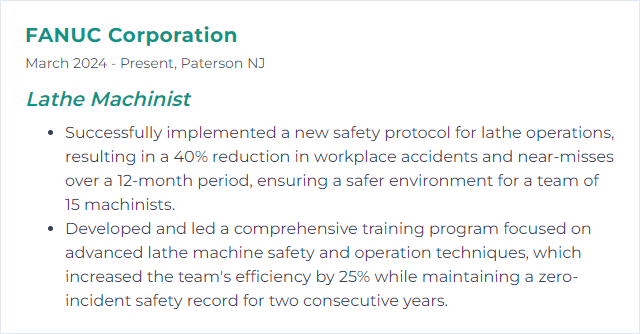Top 12 Lathe Machinist Skills to Put on Your Resume
In today’s scramble for skilled hands, a standout lathe machinist blends sharp technical sense with steady precision and a streak of problem-solving grit. Put the right skills forward on your resume and you signal reliability, speed, and care—the mix employers hunt for in modern shops.
Lathe Machinist Skills
- CNC Programming
- Precision Measurement
- Blueprint Reading
- G-Code Mastery
- CAM Software
- Tool Setting
- Manual Machining
- Haas Control
- Fanuc Control
- Quality Inspection
- Metalworking Fluids
- Safety Protocols
1. CNC Programming
CNC programming for a lathe machinist means writing instructions that command the machine to turn raw stock into precise cylindrical parts. You translate prints and intent into code and motion, controlling the cut down to thousandths.
Why It's Important
CNC programming lets you drive accuracy, repeatability, and speed. Complex profiles, tight tolerances, consistent finishes—delivered on schedule with minimal scrap.
How to Improve CNC Programming Skills
Build deeper control over moves, tools, and setups:
Know the lathe: Cutting forces, insert geometry, materials, workholding, rigidity. Basics first.
Master CAD/CAM: Turn/mill-turn toolpaths, stock models, verification, and posts. Learn how your CAM outputs the code your control expects.
Fluent in G/M codes: Canned cycles, cutter comp, threading, constant surface speed, safe starts. Read and hand-edit confidently.
Optimize toolpaths: Shorter air time, fewer rapid moves, balanced passes, controlled chip load. Protect tools and spindles.
Simulate and prove: Backplot, simulate with collisions, then run safe test cuts. Iterate fast, crash never.
Standardize: Program templates, naming, libraries for tools and holders. Consistency beats chaos.
Practice, review results, tune. Over and over—until programs run clean the first time.
How to Display CNC Programming Skills on Your Resume
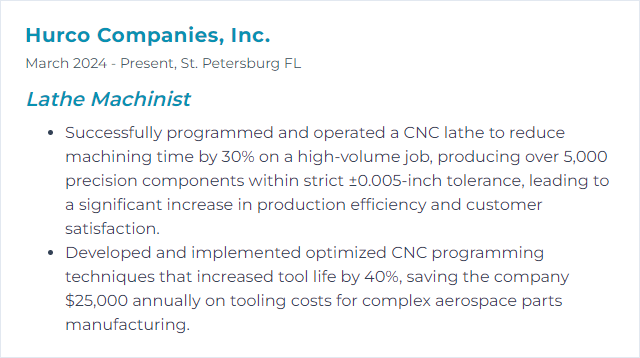
2. Precision Measurement
Precision measurement is the disciplined use of micrometers, calipers, bore gauges, indicators, and surface measurement to confirm parts meet spec—size, geometry, and finish—without guesswork.
Why It's Important
No measurement, no quality. You can’t hold tolerances you can’t verify. Accurate readings slash rework, catch drift early, and keep customers happy.
How to Improve Precision Measurement Skills
Calibrate: Establish intervals, use standards, document results. Trust the tools, because they’re checked.
Control temperature: Measure at stable temps; let parts normalize. Thermal growth lies if you ignore it.
Pick the right tool: Mic instead of caliper when tight. Bore gauge over “feel.” Match tool to tolerance.
Keep it clean: Lint-free wipes, no chips on anvils, no oil film where it shouldn’t be.
Repeatability drills: Take multiple readings, swap operators, check GR&R. Sharpen the human factor.
How to Display Precision Measurement Skills on Your Resume
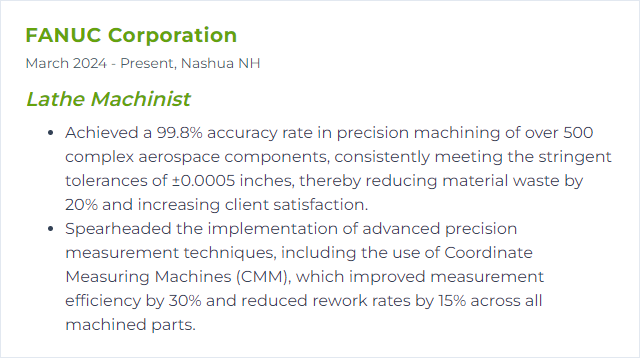
3. Blueprint Reading
Blueprint reading means decoding drawings into machining steps—dimensions, notes, views, finishes, materials, and the nuance of GD&T callouts—so the part that leaves your chuck matches the designer’s intent.
Why It's Important
Misread a tolerance and you build scrap. Understand the print properly and you set up once, run right, and pass inspection smoothly.
How to Improve Blueprint Reading Skills
Learn the language: Symbols, section views, datums, surface callouts, fits.
Study GD&T: ASME Y14.5 principles—true position, flatness, circularity, runout—applied to turning.
Practice with real drawings: Diverse parts, materials, and tolerance bands. Work through measuring strategies before cutting.
Trace process plans: From print to setup sheet to inspection plan. Visualize flow.
Peer reviews: Walk through a drawing with another machinist. Catch what solo eyes miss.
How to Display Blueprint Reading Skills on Your Resume
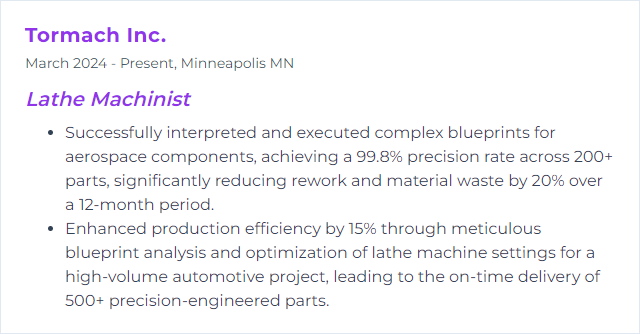
4. G-Code Mastery
G-code mastery is the ability to read, write, and tweak code for CNC lathes with confidence—canned cycles, macros, safe restarts, tool comp—so programs run fast and safe.
Why It's Important
When you own the code, you own the process. Faster setups, fewer surprises, tighter clock times.
How to Improve G-Code Mastery Skills
Memorize core sets: Start/stop blocks, motion codes, threading cycles, dwell, canned rough/finish, M-codes you use daily.
Manual practice: Write simple ops by hand. Learn what every line does. Then scale up.
Sim first: Backplot, check toolpaths, find gouges and rapids gone wild, fix before steel sees chips.
Safe starts: Modal awareness, cancel states, spindle/rpm modes. Avoid inherited settings that bite.
Optimize: Shorten programs, smart loops, macros for repetitive patterns, fewer tool changes.
How to Display G-Code Mastery Skills on Your Resume
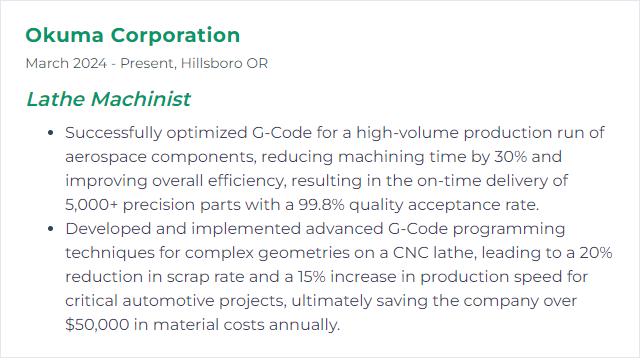
5. CAM Software
CAM (Computer-Aided Manufacturing) turns designs into toolpaths for CNC lathes. It accelerates programming, tightens consistency, and reveals collisions before they become expensive.
Why It's Important
Strong CAM chops mean faster programming, reliable posts, and predictable results across materials and machines.
How to Improve CAM Software Skills
Own the turn tools: Rough/finish, groove, part-off, threading, drilling on center and live-tool ops if applicable.
Verification habit: Stock models, rest machining, collision checks. No blind faith.
Dial in posts: Understand post variables, output formats, and how to adjust for your control.
Tool libraries: Accurate inserts, holders, nose radii, stickout, and feeds/speeds by material.
Templates and standards: Setup sheets, program headers, work offsets, and safe retracts—repeatable and shared.
Iterate for speed: Reduce air cuts, smarter entry/exit, constant chip load strategies, and balanced passes.
How to Display CAM Software Skills on Your Resume

6. Tool Setting
Tool setting means locating and securing cutting tools with precision, then establishing offsets so the machine knows exactly where the edge lives.
Why It's Important
Poor tool setting wrecks parts and finishes. Good tool setting tightens size control, reduces chatter, and preserves tool life.
How to Improve Tool Setting Skills
Use presetters or probes: Measure offline when possible, or probe on-machine. Consistency is everything.
Offsets done right: Geometry and wear offsets separated, nose radius comp correct, directions verified.
Minimize runout: Clock inserts, check holders, tighten to spec, verify with an indicator when critical.
Document setups: Photos, lengths, stickout, torque values. Reuse wins time.
Care and cleaning: Chip-free pockets, clean tapers, no dings on holders. Small details, big payoffs.
How to Display Tool Setting Skills on Your Resume
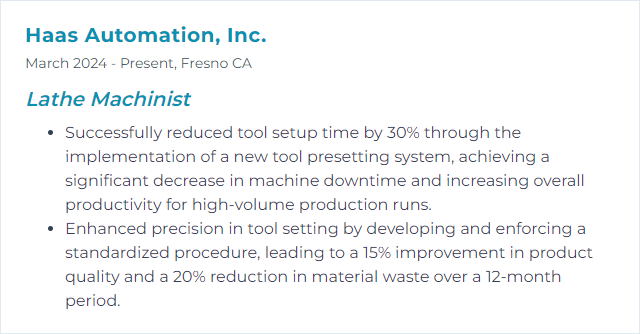
7. Manual Machining
Manual machining is hands-on turning without automation—dial reading, tool grinding, touch-offs, and careful control of feeds and speeds.
Why It's Important
It sharpens intuition. You feel the cut, hear trouble, and develop judgment that improves CNC setups and troubleshooting.
How to Improve Manual Machining Skills
Precision practice: Step turning to tenths, smooth blends, consistent chamfers, clean parting.
Speeds and feeds sense: Material behavior, tool wear signs, chip color and shape—read the clues.
Toolcraft: Grind HSS tools, hone edges, set tool height dead on center, manage nose radius.
Workholding: Dial in runout, soft jaws, between centers, expand mandrels. Secure, repeatable, safe.
Finish quality: Surface measurements, deburring finesse, polish without rounding edges that matter.
How to Display Manual Machining Skills on Your Resume
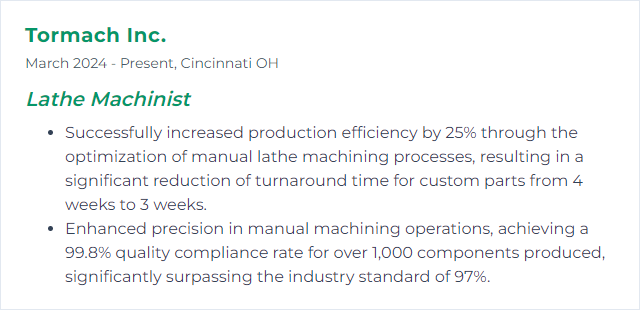
8. Haas Control
Haas Control is the interface and brain behind Haas CNC lathes—programming, offsets, probing options, diagnostics, and file management all in one place.
Why It's Important
Fluency speeds setups, reduces alarms, and unlocks features that shave minutes off every cycle.
How to Improve Haas Control Skills
Offsets and workholding: Master tool/wear offsets, work offsets, and safe retract planes.
Built-in helpers: Use VPS templates, graphics, and single-block with optional stop for safe prove-outs.
Alarm savvy: Learn common alarm codes and the quickest recovery steps.
Backups: Regularly back up parameters, offsets, and programs. Protect yourself from downtime.
Feature exploration: Tool load monitoring, high-speed options, and safe start macros—put them to use.
How to Display Haas Control Skills on Your Resume

9. Fanuc Control
Fanuc is a widely used CNC control for lathes. It’s powerful, modal, and consistent—once you learn its logic, it rewards precision and care.
Why It's Important
Fanuc literacy means portability across shops and machines, faster troubleshooting, and programs that run right the first time.
How to Improve Fanuc Control Skills
Code fluency: G50 spindle limits, G96/G97 CSS and RPM modes, threading with G76, canned turning cycles.
Custom macros: Parameterized programs, looping, conditional logic. Build reusable routines and cut code bloat.
Work offsets and CRC: G54–G59, geometry vs wear, nose radius comp with correct orientation.
Program prove-out: Graphics, single-block, feed hold, optional stop—make these reflexes.
Maintenance awareness: Clean inputs, stable power, battery and backup discipline to prevent lost settings.
How to Display Fanuc Control Skills on Your Resume

10. Quality Inspection
Quality inspection checks that finished parts meet dimensions, geometry, and surface requirements—every feature, every time, documented.
Why It's Important
Robust inspection stops bad parts at the source, reduces rework, and proves conformance to customers and audits.
How to Improve Quality Inspection Skills
Know the spec: Tolerances, GD&T, finish, and material notes—all interpreted before chips fly.
Calibrate and verify: Scheduled calibration, masters on hand, daily checks where it counts.
Smart sampling: First article inspection, in-process checks, and final checks tied to risk.
SPC where useful: Track trends, catch drift, adjust before parts go out of control.
Clear documentation: Traceable records, lot control, and feedback loops from inspection to machining.
How to Display Quality Inspection Skills on Your Resume
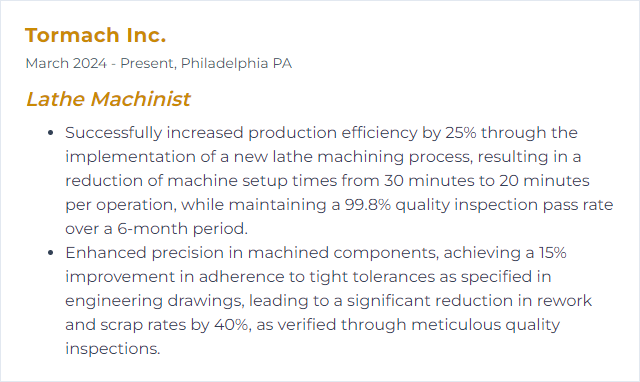
11. Metalworking Fluids
Metalworking fluids cool, lubricate, and move chips. They guard surface finish, tool life, and machine health.
Why It's Important
Right fluid, right concentration, right delivery—parts look better, tools last longer, processes run steadier.
How to Improve Metalworking Fluids Skills
Select wisely: Match oil, semi-synthetic, or synthetic to materials and operations (turn, groove, thread).
Measure concentration: Use a refractometer, adjust mix, and log readings. Consistency beats guesswork.
Keep it clean: Skim tramp oil, filter fines, maintain pH, and control bacteria. Sumps should not smell.
Optimize delivery: Nozzles aimed at the cut, adequate flow, chip evacuation handled.
Safety and disposal: SDS awareness, ventilation, proper handling, and compliant disposal procedures.
How to Display Metalworking Fluids Skills on Your Resume

12. Safety Protocols
Shop safety for lathe work is disciplined habit: secure workholding, sharp awareness around rotation, clear floors, and emergency readiness.
Why It's Important
Lathes don’t forgive. Good habits prevent entanglement, impact, and burn injuries—and keep production moving without incident.
How to Improve Safety Protocols Skills
Training that sticks: Machine-specific instruction, hazard recognition, and drills for emergency stops and fire response.
PPE, correctly applied: Always wear eye and hearing protection. No gloves around rotating spindles; use cut-resistant gloves only when handling stock or sharp parts away from a running machine. Tie back hair, no loose sleeves or jewelry, safety footwear on.
Maintenance and guarding: Guards in place, interlocks functional, chucks and tool posts inspected, alarms respected.
Safe practices: Verify clamping, remove chuck keys immediately, stand clear of the line of fire at startup, never leave a running lathe unattended.
Housekeeping and LOTO: Clean chips, dry floors, labeled chemicals, and lockout/tagout during service.
How to Display Safety Protocols Skills on Your Resume
